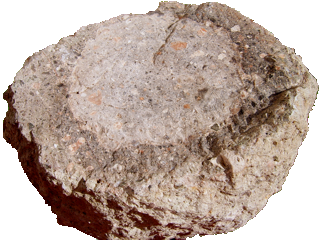Neptunistic Geology - Neptunistische Geologie
The neptunistic geology, NG, follows a path that resulted from found material without any intention to destroy the existing gology. More about this in:
History of the NG.
Here are the most important results of the neptunistic geology:
| 1. | Almost all non-effusive plutonic rocks are primarily sedimentary and secondary metamorphic. Effusive appearance afterwards is not excluded. |
| 2. | Structures of metamorphic rocks are too often subject to metamorphosis. The structures of the starting materials are undervalued. The chemistry of metamorphoses is not directly the discussion material of the neptunistic geology. |
| 3. | Fissures and folds up to about 50 meters are predominantly pseudotectonics, i.e. assigned to syngenetic and post-biogenetic structuring. The classic geology classifies them a priori as tectonics. |
| 4. | The most significant proportion of spheres in rocks is bio-sedimentary. The classification as concretions mostly does not apply. Spheres are an indicator of biogenesis, which can be verified with other indicators. |
| 5. | Results of the neptunistic geology also concern: Alpine fissures, aplites, ore genesis, layered intrusions, mylonites, gap fillings, cockade ores, contact yards, pegmatites, slickensides, spherulites, xenolites and others. |
Die neptunistische Geologie, NG, geht einen Weg, der sich ohne Absicht die bestehende Gologie in Frage zu stellen, aus Fundmaterial ergab. Mehr darüber in: Geschichte der neptunistischen Geologie.
Hier sind bedeutende Ergebnisse der neptunistischen Geologie kurz genannt:
| 1. | Nahezu alle nicht effusiven, plutonischen, Gesteine sind primär sedimentär und sekundär metamorph. Effusives Erscheinen danach ist nicht ausgeschlossen. |
| 2. | Strukturen metamorpher Gesteine werden zu oft der Metamorphose unterstellt. Die Strukturen der Edukte sind unterbewertet. Die Chemie der Metamorphosen ist aber nicht Diskussionsstoff der neptunistischen Geologie |
| 3. | Klüftungen und Faltungen bis etwa 50 Meter sind vorwiegend Pseudotektonik, d. h. syngenetischen und biotischen Strukturierungen zugeordnet. Die klassische Geologie ordnet sie a priori als Tektonik ein. |
| 4. | Der bedeutendste Anteil von Kugelbildungen in Gesteinen ist biosedimentär. Die Einordnung als Konkretionen trifft überwiegend nicht zu. Kugelbildungen sind ein Indikator für Biogenese, die mit weiteren Indikatoren verifiziert werden kann. |
| 5. | Ergebnisse der neptunistischen Geologie betreffen auch: Alpine Zerrklüfte, Aplite, Erzgenesen, Geschichtete Intrusionen, Harnische, Mylonite, Kluftfüllungen, Kokardenerze, Kontakthöfe, Pegmatite, Sphärolithe, Xenolithe und andere. |
 Looking for stuff
Looking for stuff

2. Aktualisierung 10.05.2020
3. Aktualisierung 11.01.2021
